1996 CHRYSLER VOYAGER check engine
[x] Cancel search: check enginePage 1136 of 1938
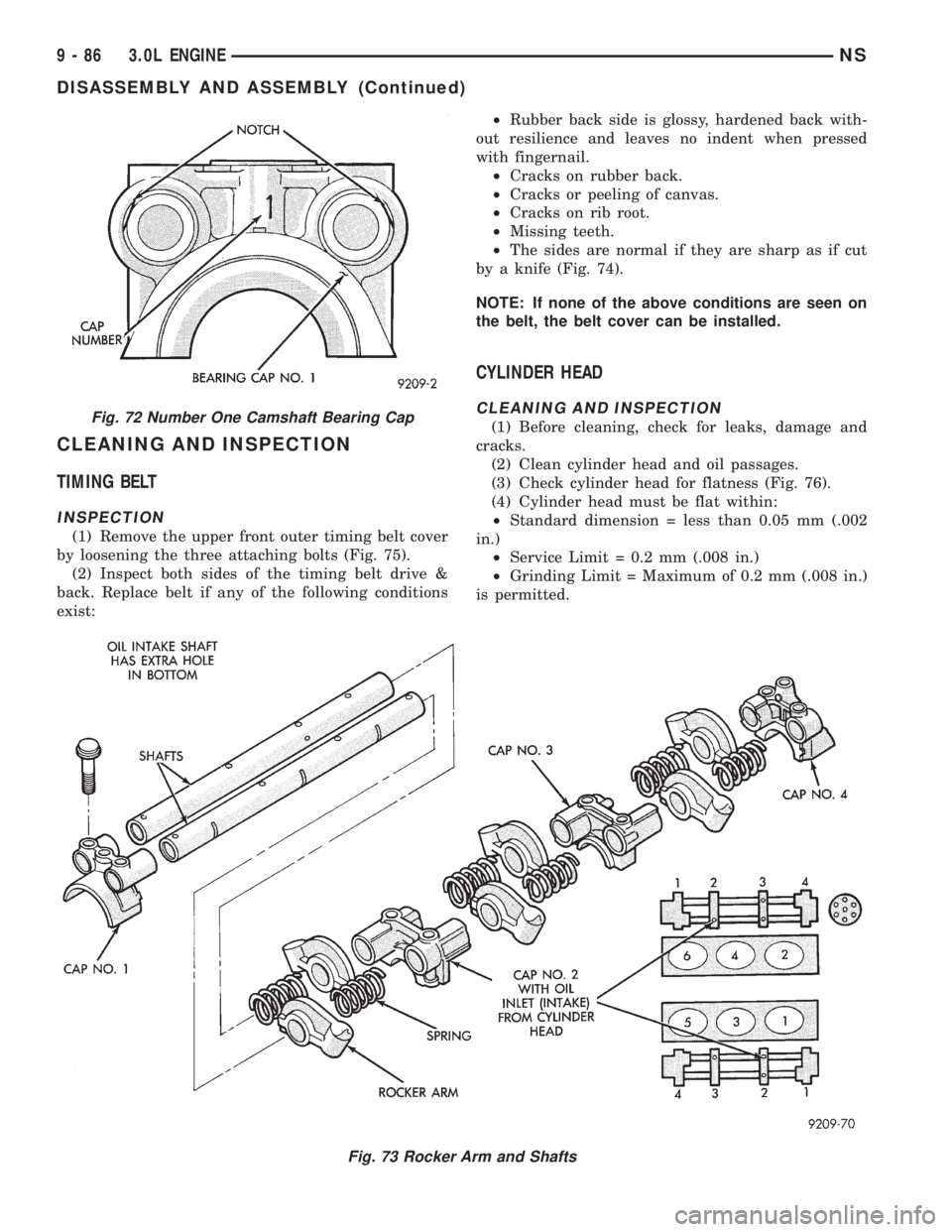
CLEANING AND INSPECTION
TIMING BELT
INSPECTION
(1) Remove the upper front outer timing belt cover
by loosening the three attaching bolts (Fig. 75).
(2) Inspect both sides of the timing belt drive &
back. Replace belt if any of the following conditions
exist:²Rubber back side is glossy, hardened back with-
out resilience and leaves no indent when pressed
with fingernail.
²Cracks on rubber back.
²Cracks or peeling of canvas.
²Cracks on rib root.
²Missing teeth.
²The sides are normal if they are sharp as if cut
by a knife (Fig. 74).
NOTE: If none of the above conditions are seen on
the belt, the belt cover can be installed.
CYLINDER HEAD
CLEANING AND INSPECTION
(1) Before cleaning, check for leaks, damage and
cracks.
(2) Clean cylinder head and oil passages.
(3) Check cylinder head for flatness (Fig. 76).
(4) Cylinder head must be flat within:
²Standard dimension = less than 0.05 mm (.002
in.)
²Service Limit = 0.2 mm (.008 in.)
²Grinding Limit = Maximum of 0.2 mm (.008 in.)
is permitted.
Fig. 73 Rocker Arm and Shafts
Fig. 72 Number One Camshaft Bearing Cap
9 - 86 3.0L ENGINENS
DISASSEMBLY AND ASSEMBLY (Continued)
Page 1137 of 1938
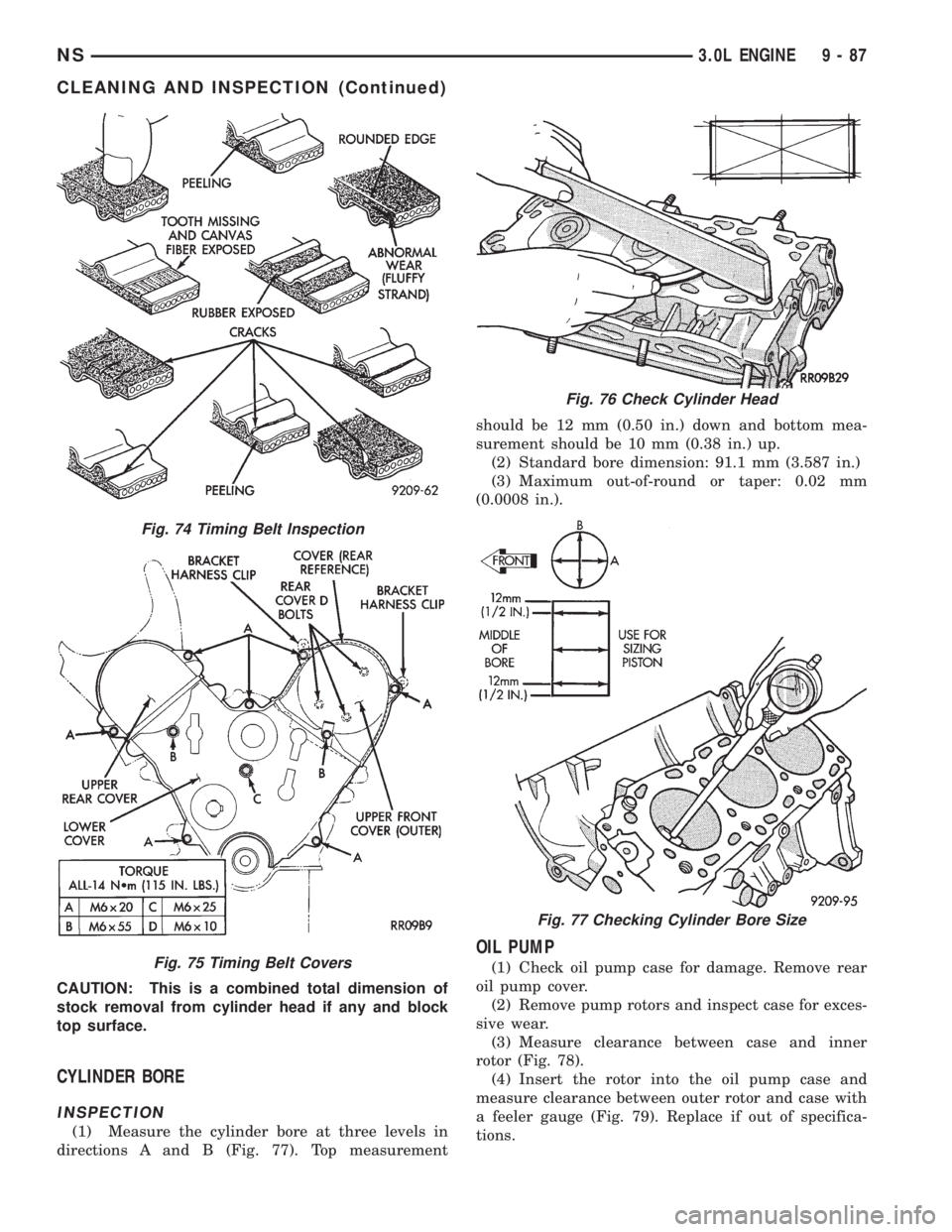
CAUTION: This is a combined total dimension of
stock removal from cylinder head if any and block
top surface.
CYLINDER BORE
INSPECTION
(1) Measure the cylinder bore at three levels in
directions A and B (Fig. 77). Top measurementshould be 12 mm (0.50 in.) down and bottom mea-
surement should be 10 mm (0.38 in.) up.
(2) Standard bore dimension: 91.1 mm (3.587 in.)
(3) Maximum out-of-round or taper: 0.02 mm
(0.0008 in.).
OIL PUMP
(1) Check oil pump case for damage. Remove rear
oil pump cover.
(2) Remove pump rotors and inspect case for exces-
sive wear.
(3) Measure clearance between case and inner
rotor (Fig. 78).
(4) Insert the rotor into the oil pump case and
measure clearance between outer rotor and case with
a feeler gauge (Fig. 79). Replace if out of specifica-
tions.
Fig. 74 Timing Belt Inspection
Fig. 75 Timing Belt Covers
Fig. 76 Check Cylinder Head
Fig. 77 Checking Cylinder Bore Size
NS3.0L ENGINE 9 - 87
CLEANING AND INSPECTION (Continued)
Page 1138 of 1938
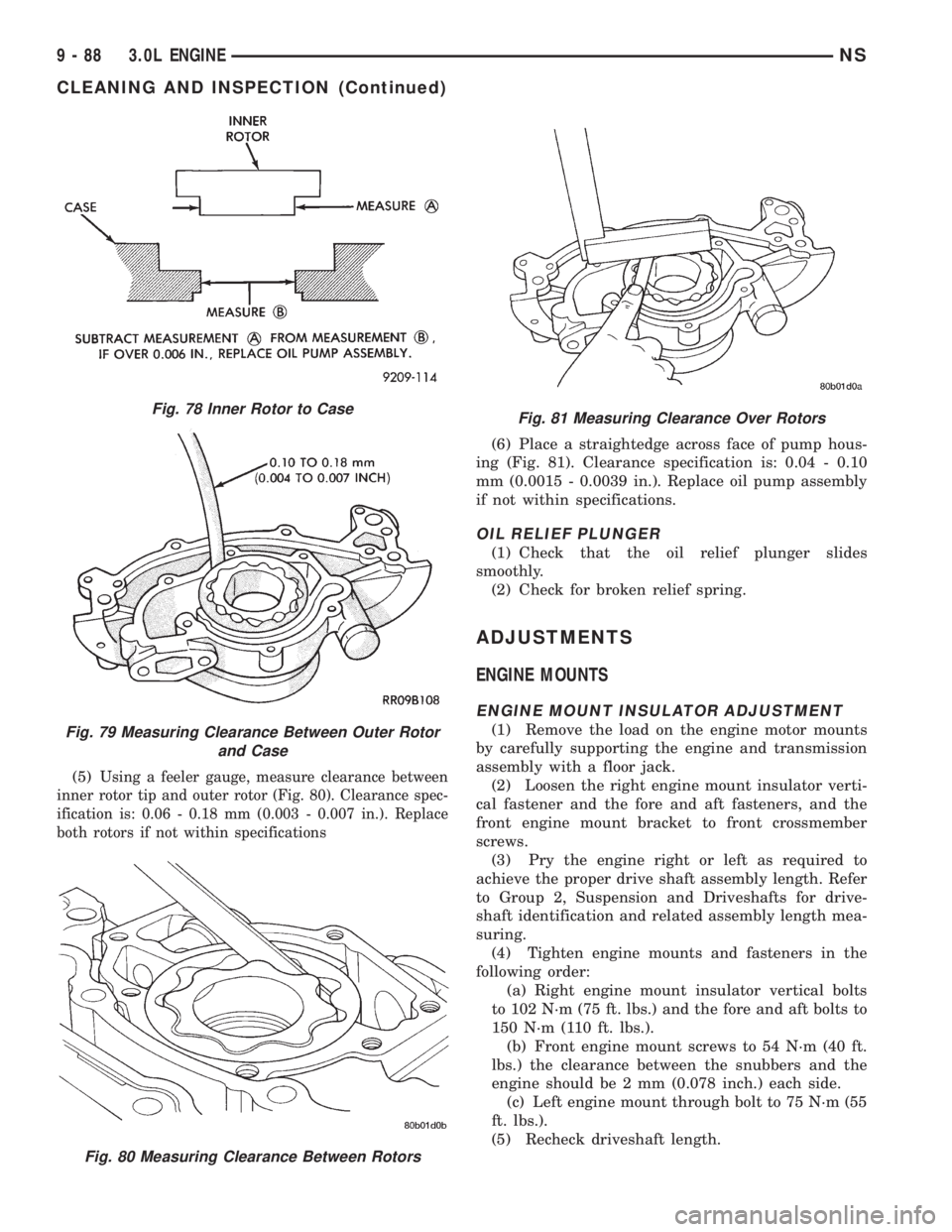
(5)Using a feeler gauge, measure clearance between
inner rotor tip and outer rotor (Fig. 80). Clearance spec-
ification is: 0.06 - 0.18 mm (0.003 - 0.007 in.). Replace
both rotors if not within specifications
(6) Place a straightedge across face of pump hous-
ing (Fig. 81). Clearance specification is: 0.04 - 0.10
mm (0.0015 - 0.0039 in.). Replace oil pump assembly
if not within specifications.
OIL RELIEF PLUNGER
(1) Check that the oil relief plunger slides
smoothly.
(2) Check for broken relief spring.
ADJUSTMENTS
ENGINE MOUNTS
ENGINE MOUNT INSULATOR ADJUSTMENT
(1) Remove the load on the engine motor mounts
by carefully supporting the engine and transmission
assembly with a floor jack.
(2) Loosen the right engine mount insulator verti-
cal fastener and the fore and aft fasteners, and the
front engine mount bracket to front crossmember
screws.
(3) Pry the engine right or left as required to
achieve the proper drive shaft assembly length. Refer
to Group 2, Suspension and Driveshafts for drive-
shaft identification and related assembly length mea-
suring.
(4) Tighten engine mounts and fasteners in the
following order:
(a) Right engine mount insulator vertical bolts
to 102 N´m (75 ft. lbs.) and the fore and aft bolts to
150 N´m (110 ft. lbs.).
(b) Front engine mount screws to 54 N´m (40 ft.
lbs.) the clearance between the snubbers and the
engine should be 2 mm (0.078 inch.) each side.
(c) Left engine mount through bolt to 75 N´m (55
ft. lbs.).
(5) Recheck driveshaft length.
Fig. 78 Inner Rotor to Case
Fig. 79 Measuring Clearance Between Outer Rotor
and Case
Fig. 80 Measuring Clearance Between Rotors
Fig. 81 Measuring Clearance Over Rotors
9 - 88 3.0L ENGINENS
CLEANING AND INSPECTION (Continued)
Page 1143 of 1938
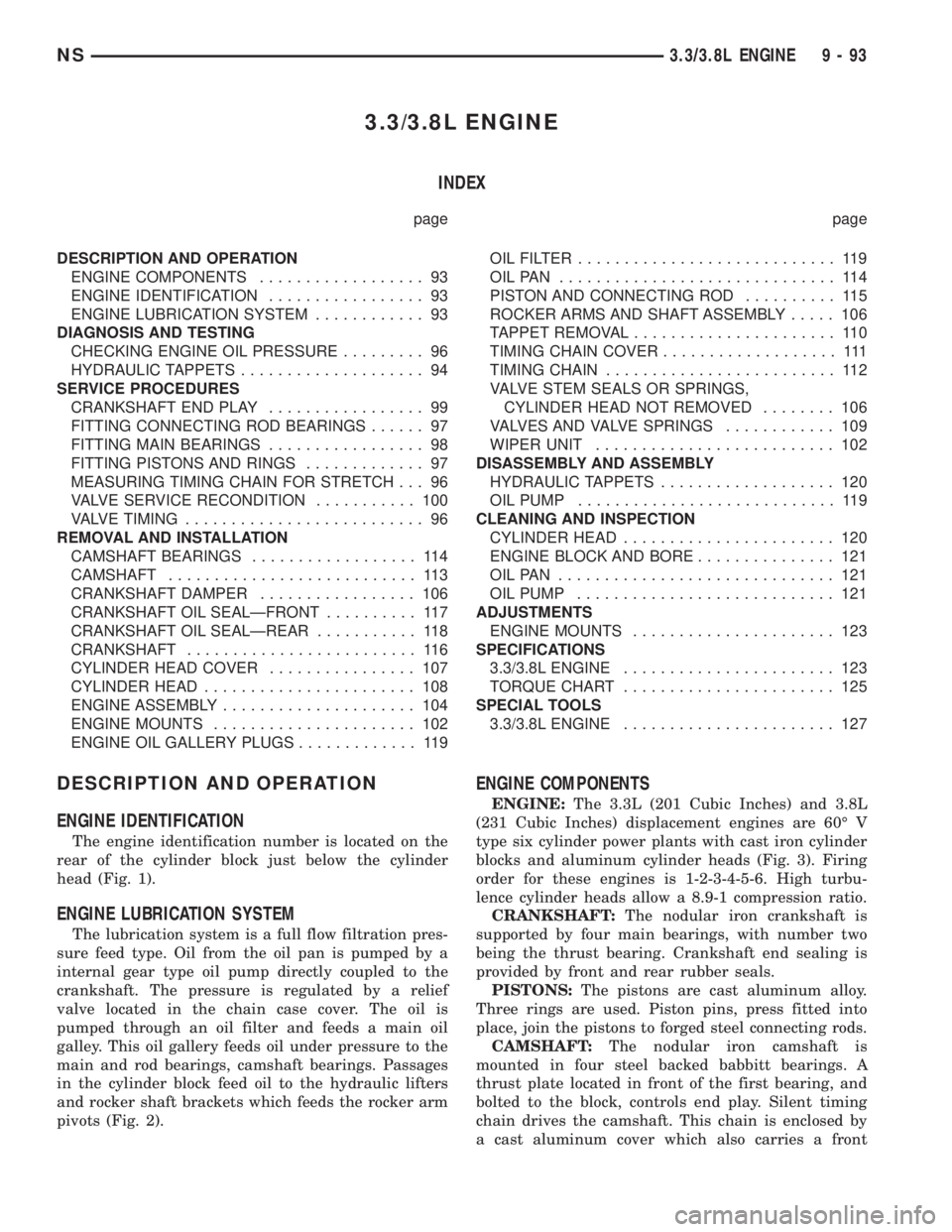
3.3/3.8L ENGINE
INDEX
page page
DESCRIPTION AND OPERATION
ENGINE COMPONENTS.................. 93
ENGINE IDENTIFICATION................. 93
ENGINE LUBRICATION SYSTEM............ 93
DIAGNOSIS AND TESTING
CHECKING ENGINE OIL PRESSURE......... 96
HYDRAULIC TAPPETS.................... 94
SERVICE PROCEDURES
CRANKSHAFT END PLAY................. 99
FITTING CONNECTING ROD BEARINGS...... 97
FITTING MAIN BEARINGS................. 98
FITTING PISTONS AND RINGS............. 97
MEASURING TIMING CHAIN FOR STRETCH . . . 96
VALVE SERVICE RECONDITION........... 100
VALVE TIMING.......................... 96
REMOVAL AND INSTALLATION
CAMSHAFT BEARINGS.................. 114
CAMSHAFT........................... 113
CRANKSHAFT DAMPER................. 106
CRANKSHAFT OIL SEALÐFRONT.......... 117
CRANKSHAFT OIL SEALÐREAR........... 118
CRANKSHAFT......................... 116
CYLINDER HEAD COVER................ 107
CYLINDER HEAD....................... 108
ENGINE ASSEMBLY..................... 104
ENGINE MOUNTS...................... 102
ENGINE OIL GALLERY PLUGS............. 119OILFILTER ............................ 119
OILPAN .............................. 114
PISTON AND CONNECTING ROD.......... 115
ROCKER ARMS AND SHAFT ASSEMBLY..... 106
TAPPET REMOVAL...................... 110
TIMING CHAIN COVER................... 111
TIMING CHAIN......................... 112
VALVE STEM SEALS OR SPRINGS,
CYLINDER HEAD NOT REMOVED........ 106
VALVES AND VALVE SPRINGS............ 109
WIPER UNIT.......................... 102
DISASSEMBLY AND ASSEMBLY
HYDRAULIC TAPPETS................... 120
OIL PUMP............................ 119
CLEANING AND INSPECTION
CYLINDER HEAD....................... 120
ENGINE BLOCK AND BORE............... 121
OILPAN .............................. 121
OIL PUMP............................ 121
ADJUSTMENTS
ENGINE MOUNTS...................... 123
SPECIFICATIONS
3.3/3.8L ENGINE....................... 123
TORQUE CHART....................... 125
SPECIAL TOOLS
3.3/3.8L ENGINE....................... 127
DESCRIPTION AND OPERATION
ENGINE IDENTIFICATION
The engine identification number is located on the
rear of the cylinder block just below the cylinder
head (Fig. 1).
ENGINE LUBRICATION SYSTEM
The lubrication system is a full flow filtration pres-
sure feed type. Oil from the oil pan is pumped by a
internal gear type oil pump directly coupled to the
crankshaft. The pressure is regulated by a relief
valve located in the chain case cover. The oil is
pumped through an oil filter and feeds a main oil
galley. This oil gallery feeds oil under pressure to the
main and rod bearings, camshaft bearings. Passages
in the cylinder block feed oil to the hydraulic lifters
and rocker shaft brackets which feeds the rocker arm
pivots (Fig. 2).
ENGINE COMPONENTS
ENGINE:The 3.3L (201 Cubic Inches) and 3.8L
(231 Cubic Inches) displacement engines are 60É V
type six cylinder power plants with cast iron cylinder
blocks and aluminum cylinder heads (Fig. 3). Firing
order for these engines is 1-2-3-4-5-6. High turbu-
lence cylinder heads allow a 8.9-1 compression ratio.
CRANKSHAFT:The nodular iron crankshaft is
supported by four main bearings, with number two
being the thrust bearing. Crankshaft end sealing is
provided by front and rear rubber seals.
PISTONS:The pistons are cast aluminum alloy.
Three rings are used. Piston pins, press fitted into
place, join the pistons to forged steel connecting rods.
CAMSHAFT:The nodular iron camshaft is
mounted in four steel backed babbitt bearings. A
thrust plate located in front of the first bearing, and
bolted to the block, controls end play. Silent timing
chain drives the camshaft. This chain is enclosed by
a cast aluminum cover which also carries a front
NS3.3/3.8L ENGINE 9 - 93
Page 1145 of 1938
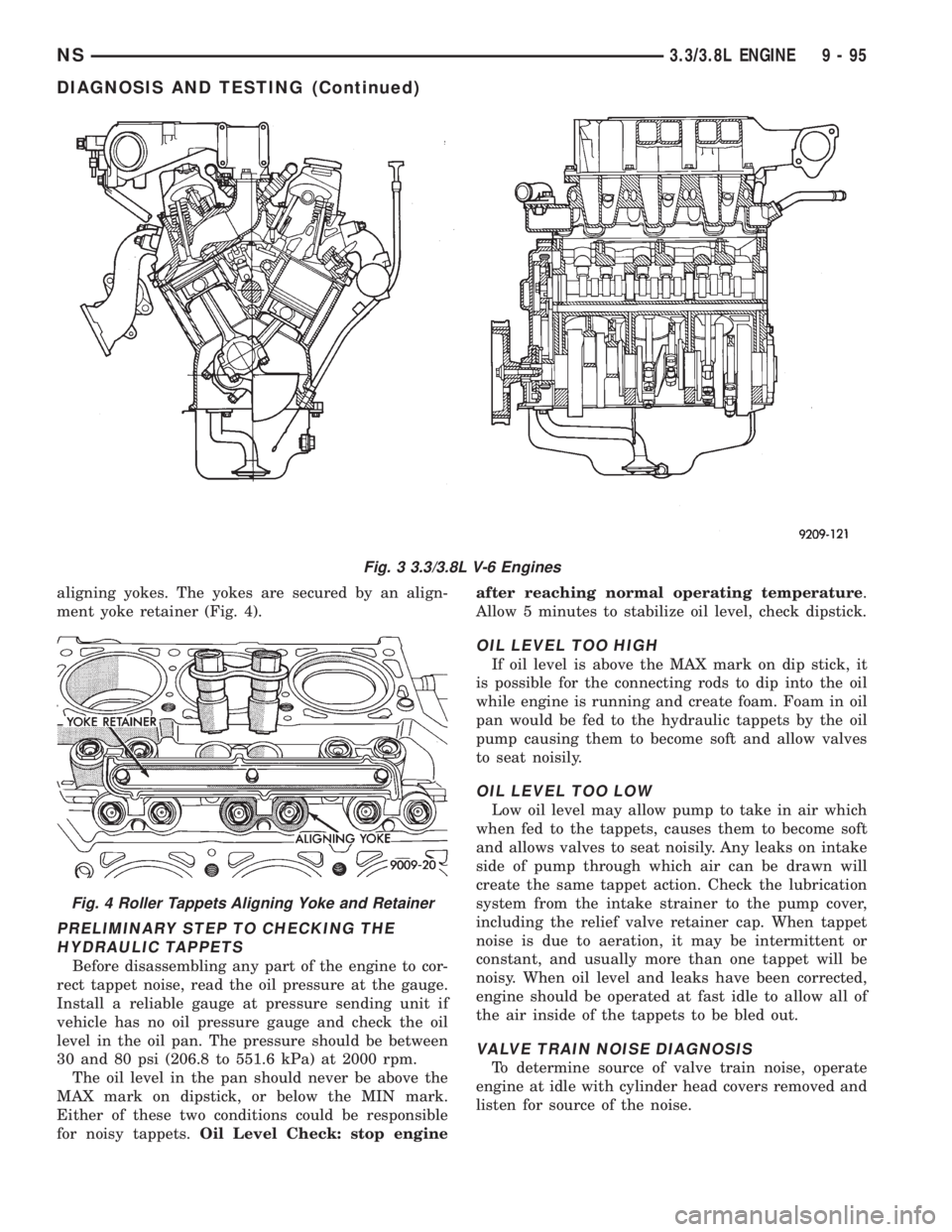
aligning yokes. The yokes are secured by an align-
ment yoke retainer (Fig. 4).
PRELIMINARY STEP TO CHECKING THE
HYDRAULIC TAPPETS
Before disassembling any part of the engine to cor-
rect tappet noise, read the oil pressure at the gauge.
Install a reliable gauge at pressure sending unit if
vehicle has no oil pressure gauge and check the oil
level in the oil pan. The pressure should be between
30 and 80 psi (206.8 to 551.6 kPa) at 2000 rpm.
The oil level in the pan should never be above the
MAX mark on dipstick, or below the MIN mark.
Either of these two conditions could be responsible
for noisy tappets.Oil Level Check: stop engineafter reaching normal operating temperature.
Allow 5 minutes to stabilize oil level, check dipstick.
OIL LEVEL TOO HIGH
If oil level is above the MAX mark on dip stick, it
is possible for the connecting rods to dip into the oil
while engine is running and create foam. Foam in oil
pan would be fed to the hydraulic tappets by the oil
pump causing them to become soft and allow valves
to seat noisily.
OIL LEVEL TOO LOW
Low oil level may allow pump to take in air which
when fed to the tappets, causes them to become soft
and allows valves to seat noisily. Any leaks on intake
side of pump through which air can be drawn will
create the same tappet action. Check the lubrication
system from the intake strainer to the pump cover,
including the relief valve retainer cap. When tappet
noise is due to aeration, it may be intermittent or
constant, and usually more than one tappet will be
noisy. When oil level and leaks have been corrected,
engine should be operated at fast idle to allow all of
the air inside of the tappets to be bled out.
VALVE TRAIN NOISE DIAGNOSIS
To determine source of valve train noise, operate
engine at idle with cylinder head covers removed and
listen for source of the noise.
Fig. 3 3.3/3.8L V-6 Engines
Fig. 4 Roller Tappets Aligning Yoke and Retainer
NS3.3/3.8L ENGINE 9 - 95
DIAGNOSIS AND TESTING (Continued)
Page 1146 of 1938
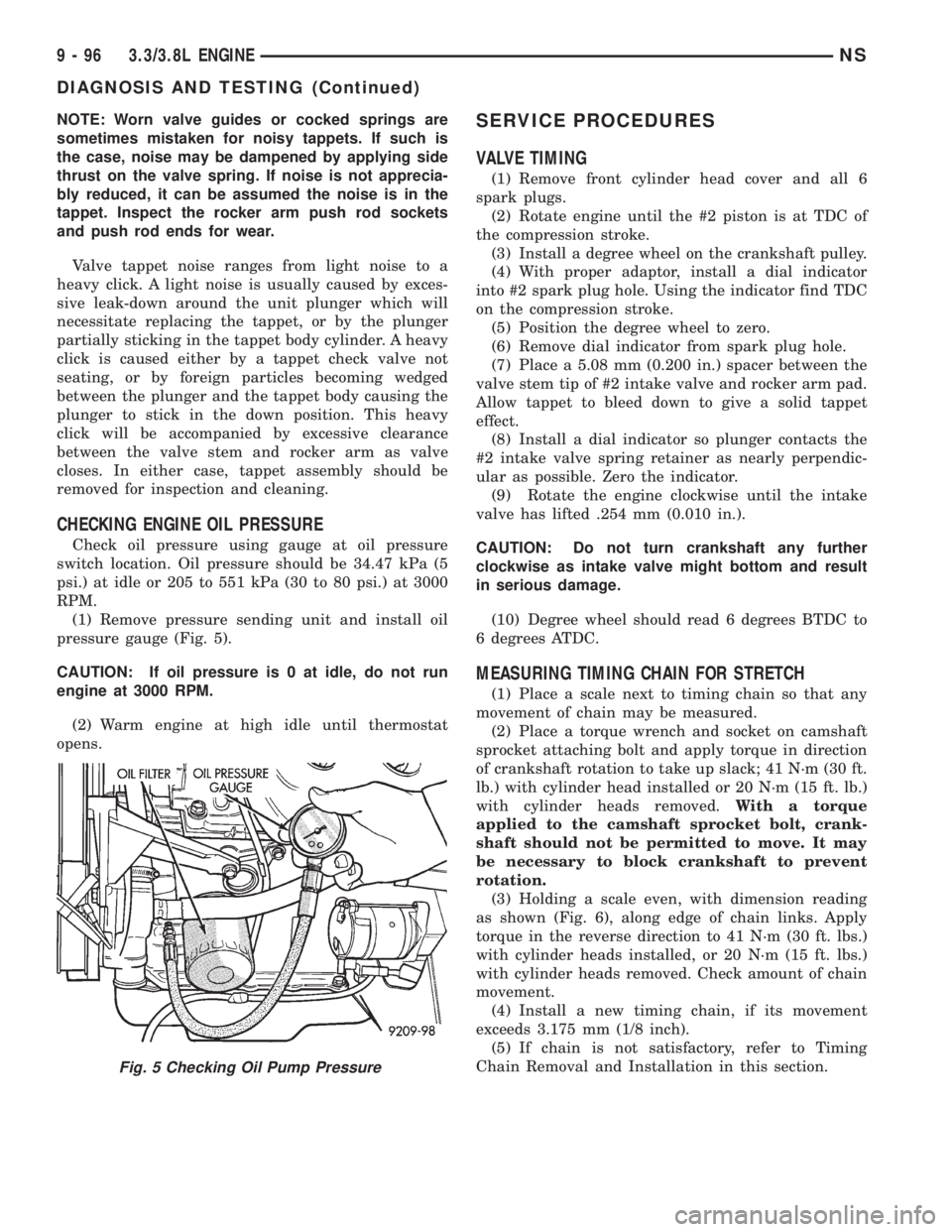
NOTE: Worn valve guides or cocked springs are
sometimes mistaken for noisy tappets. If such is
the case, noise may be dampened by applying side
thrust on the valve spring. If noise is not apprecia-
bly reduced, it can be assumed the noise is in the
tappet. Inspect the rocker arm push rod sockets
and push rod ends for wear.
Valve tappet noise ranges from light noise to a
heavy click. A light noise is usually caused by exces-
sive leak-down around the unit plunger which will
necessitate replacing the tappet, or by the plunger
partially sticking in the tappet body cylinder. A heavy
click is caused either by a tappet check valve not
seating, or by foreign particles becoming wedged
between the plunger and the tappet body causing the
plunger to stick in the down position. This heavy
click will be accompanied by excessive clearance
between the valve stem and rocker arm as valve
closes. In either case, tappet assembly should be
removed for inspection and cleaning.
CHECKING ENGINE OIL PRESSURE
Check oil pressure using gauge at oil pressure
switch location. Oil pressure should be 34.47 kPa (5
psi.) at idle or 205 to 551 kPa (30 to 80 psi.) at 3000
RPM.
(1) Remove pressure sending unit and install oil
pressure gauge (Fig. 5).
CAUTION: If oil pressure is 0 at idle, do not run
engine at 3000 RPM.
(2) Warm engine at high idle until thermostat
opens.
SERVICE PROCEDURES
VALVE TIMING
(1) Remove front cylinder head cover and all 6
spark plugs.
(2) Rotate engine until the #2 piston is at TDC of
the compression stroke.
(3) Install a degree wheel on the crankshaft pulley.
(4) With proper adaptor, install a dial indicator
into #2 spark plug hole. Using the indicator find TDC
on the compression stroke.
(5) Position the degree wheel to zero.
(6) Remove dial indicator from spark plug hole.
(7) Place a 5.08 mm (0.200 in.) spacer between the
valve stem tip of #2 intake valve and rocker arm pad.
Allow tappet to bleed down to give a solid tappet
effect.
(8) Install a dial indicator so plunger contacts the
#2 intake valve spring retainer as nearly perpendic-
ular as possible. Zero the indicator.
(9) Rotate the engine clockwise until the intake
valve has lifted .254 mm (0.010 in.).
CAUTION: Do not turn crankshaft any further
clockwise as intake valve might bottom and result
in serious damage.
(10) Degree wheel should read 6 degrees BTDC to
6 degrees ATDC.
MEASURING TIMING CHAIN FOR STRETCH
(1) Place a scale next to timing chain so that any
movement of chain may be measured.
(2) Place a torque wrench and socket on camshaft
sprocket attaching bolt and apply torque in direction
of crankshaft rotation to take up slack; 41 N´m (30 ft.
lb.) with cylinder head installed or 20 N´m (15 ft. lb.)
with cylinder heads removed.With a torque
applied to the camshaft sprocket bolt, crank-
shaft should not be permitted to move. It may
be necessary to block crankshaft to prevent
rotation.
(3) Holding a scale even, with dimension reading
as shown (Fig. 6), along edge of chain links. Apply
torque in the reverse direction to 41 N´m (30 ft. lbs.)
with cylinder heads installed, or 20 N´m (15 ft. lbs.)
with cylinder heads removed. Check amount of chain
movement.
(4) Install a new timing chain, if its movement
exceeds 3.175 mm (1/8 inch).
(5) If chain is not satisfactory, refer to Timing
Chain Removal and Installation in this section.
Fig. 5 Checking Oil Pump Pressure
9 - 96 3.3/3.8L ENGINENS
DIAGNOSIS AND TESTING (Continued)
Page 1147 of 1938
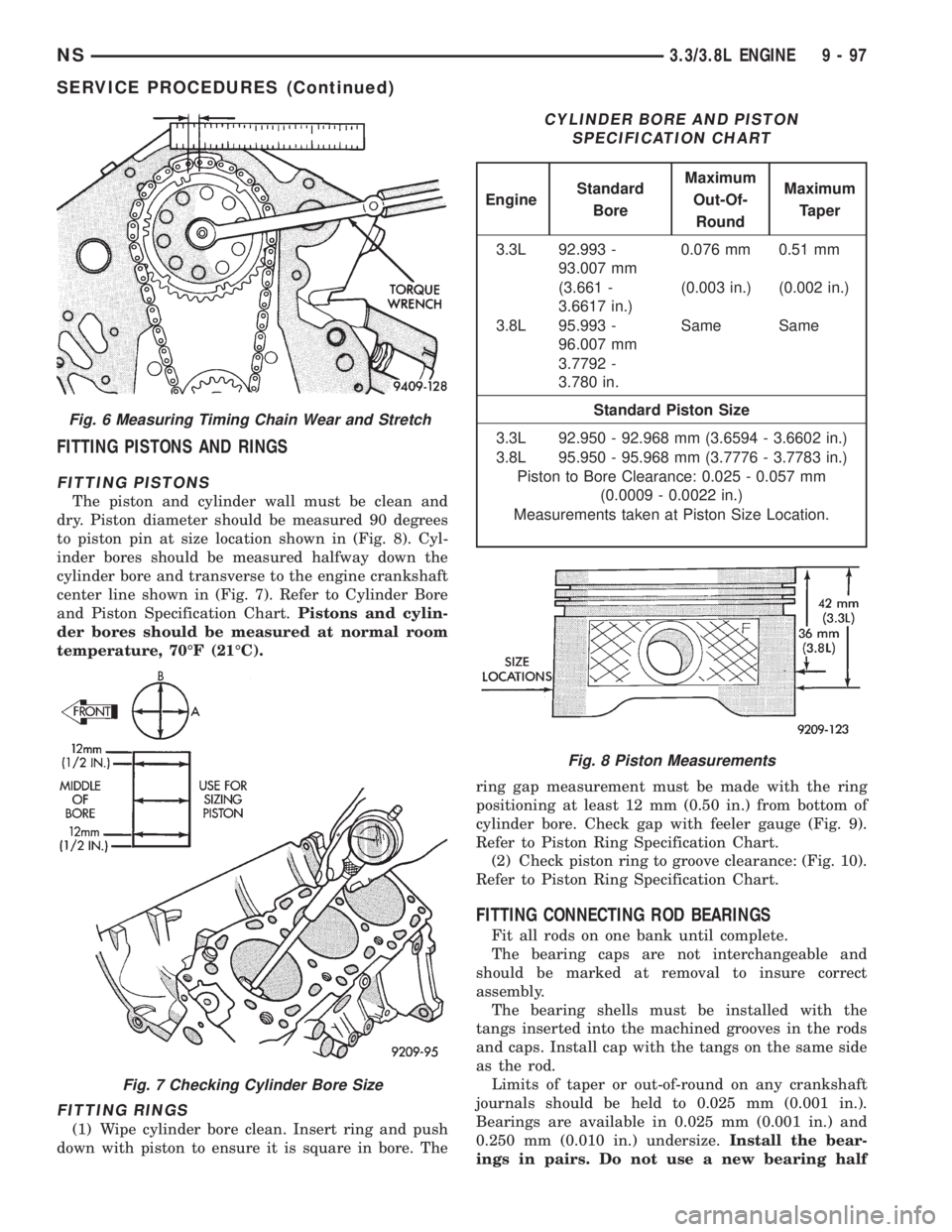
FITTING PISTONS AND RINGS
FITTING PISTONS
The piston and cylinder wall must be clean and
dry. Piston diameter should be measured 90 degrees
to piston pin at size location shown in (Fig. 8). Cyl-
inder bores should be measured halfway down the
cylinder bore and transverse to the engine crankshaft
center line shown in (Fig. 7). Refer to Cylinder Bore
and Piston Specification Chart.Pistons and cylin-
der bores should be measured at normal room
temperature, 70ÉF (21ÉC).
FITTING RINGS
(1) Wipe cylinder bore clean. Insert ring and push
down with piston to ensure it is square in bore. Thering gap measurement must be made with the ring
positioning at least 12 mm (0.50 in.) from bottom of
cylinder bore. Check gap with feeler gauge (Fig. 9).
Refer to Piston Ring Specification Chart.
(2) Check piston ring to groove clearance: (Fig. 10).
Refer to Piston Ring Specification Chart.
FITTING CONNECTING ROD BEARINGS
Fit all rods on one bank until complete.
The bearing caps are not interchangeable and
should be marked at removal to insure correct
assembly.
The bearing shells must be installed with the
tangs inserted into the machined grooves in the rods
and caps. Install cap with the tangs on the same side
as the rod.
Limits of taper or out-of-round on any crankshaft
journals should be held to 0.025 mm (0.001 in.).
Bearings are available in 0.025 mm (0.001 in.) and
0.250 mm (0.010 in.) undersize.Install the bear-
ings in pairs. Do not use a new bearing half
Fig. 6 Measuring Timing Chain Wear and Stretch
Fig. 7 Checking Cylinder Bore Size
CYLINDER BORE AND PISTON
SPECIFICATION CHART
EngineStandard
BoreMaximum
Out-Of-
RoundMaximum
Taper
3.3L 92.993 -
93.007 mm0.076 mm 0.51 mm
(3.661 -
3.6617 in.)(0.003 in.) (0.002 in.)
3.8L 95.993 -
96.007 mmSame Same
3.7792 -
3.780 in.
Standard Piston Size
3.3L 92.950 - 92.968 mm (3.6594 - 3.6602 in.)
3.8L 95.950 - 95.968 mm (3.7776 - 3.7783 in.)
Piston to Bore Clearance: 0.025 - 0.057 mm
(0.0009 - 0.0022 in.)
Measurements taken at Piston Size Location.
Fig. 8 Piston Measurements
NS3.3/3.8L ENGINE 9 - 97
SERVICE PROCEDURES (Continued)
Page 1148 of 1938
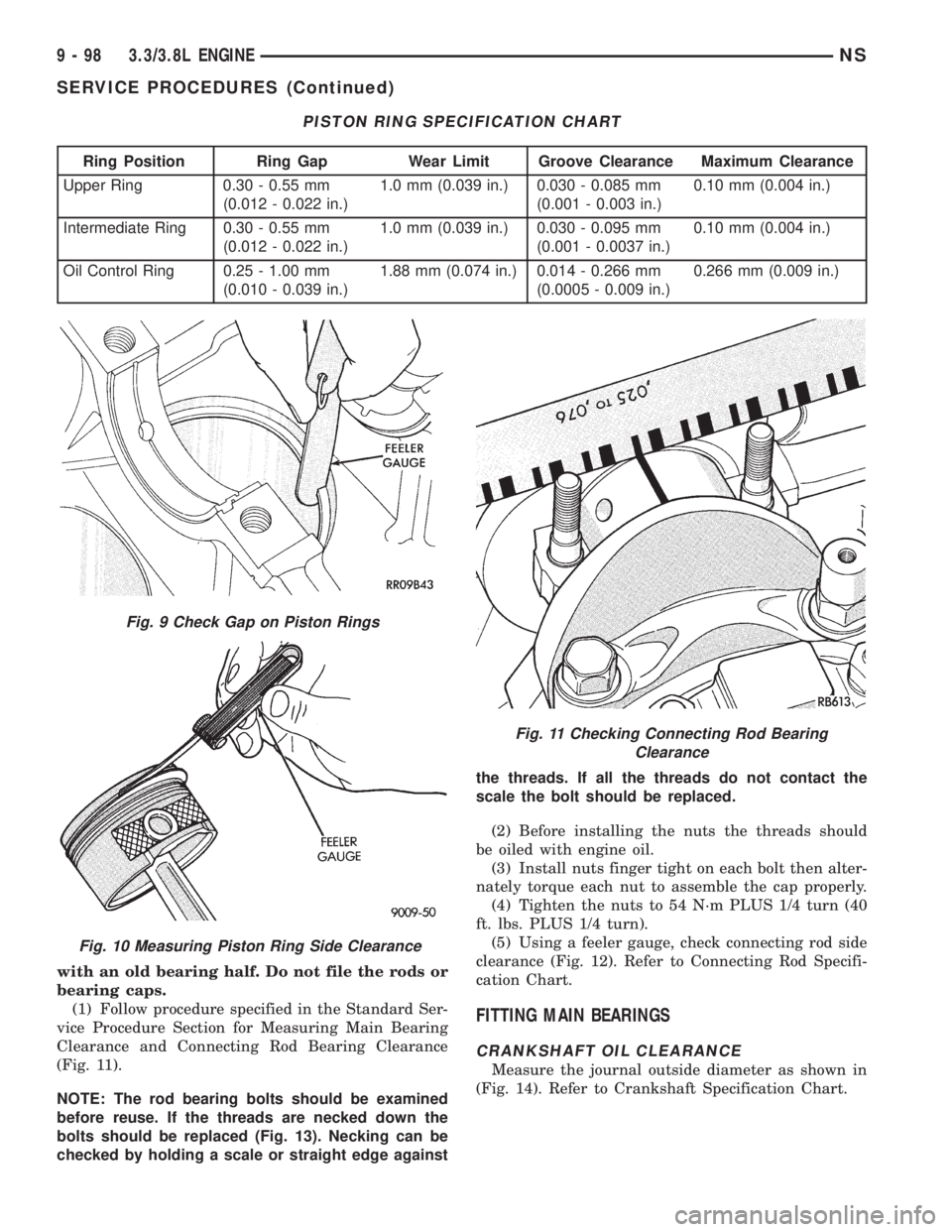
with an old bearing half. Do not file the rods or
bearing caps.
(1) Follow procedure specified in the Standard Ser-
vice Procedure Section for Measuring Main Bearing
Clearance and Connecting Rod Bearing Clearance
(Fig. 11).
NOTE: The rod bearing bolts should be examined
before reuse. If the threads are necked down the
bolts should be replaced (Fig. 13). Necking can be
checked by holding a scale or straight edge againstthe threads. If all the threads do not contact the
scale the bolt should be replaced.
(2) Before installing the nuts the threads should
be oiled with engine oil.
(3) Install nuts finger tight on each bolt then alter-
nately torque each nut to assemble the cap properly.
(4) Tighten the nuts to 54 N´m PLUS 1/4 turn (40
ft. lbs. PLUS 1/4 turn).
(5) Using a feeler gauge, check connecting rod side
clearance (Fig. 12). Refer to Connecting Rod Specifi-
cation Chart.
FITTING MAIN BEARINGS
CRANKSHAFT OIL CLEARANCE
Measure the journal outside diameter as shown in
(Fig. 14). Refer to Crankshaft Specification Chart.
PISTON RING SPECIFICATION CHART
Ring Position Ring Gap Wear Limit Groove Clearance Maximum Clearance
Upper Ring 0.30 - 0.55 mm
(0.012 - 0.022 in.)1.0 mm (0.039 in.) 0.030 - 0.085 mm
(0.001 - 0.003 in.)0.10 mm (0.004 in.)
Intermediate Ring 0.30 - 0.55 mm
(0.012 - 0.022 in.)1.0 mm (0.039 in.) 0.030 - 0.095 mm
(0.001 - 0.0037 in.)0.10 mm (0.004 in.)
Oil Control Ring 0.25 - 1.00 mm
(0.010 - 0.039 in.)1.88 mm (0.074 in.) 0.014 - 0.266 mm
(0.0005 - 0.009 in.)0.266 mm (0.009 in.)
Fig. 9 Check Gap on Piston Rings
Fig. 10 Measuring Piston Ring Side Clearance
Fig. 11 Checking Connecting Rod Bearing
Clearance
9 - 98 3.3/3.8L ENGINENS
SERVICE PROCEDURES (Continued)